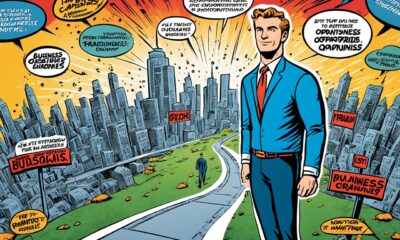Growing a Business
Il Potere della Leadership Silenziosa Svelato
Oltre il rumore della leadership tradizionale, scopri come il silenzio può trasformare il tuo team in modi sorprendenti…

Il potere della leadership silenziosa risiede nella sua capacità di ispirare fiducia e collaborazione attraverso l'ascolto attivo e l'influenza sottile. Questo stile di leadership mostra una fiducia tranquilla, promuovendo un ambiente di supporto in cui i membri del team si sentono apprezzati e coinvolti. Prioritizzando l'intelligenza emotiva e l'empatia, i leader silenziosi creano condizioni per un miglior processo decisionale e aumento della produttività. Esempi reali includono figure influenti come Mahatma Gandhi e Warren Buffett, che hanno raggiunto un successo straordinario attraverso questo approccio. Comprendere come implementare efficacemente la leadership silenziosa può migliorare notevolmente la dinamica del team e il successo organizzativo. Esplora ulteriormente per scoprire strategie che amplificano questo stile di leadership impattante.
Punti chiave
- La leadership silenziosa enfatizza l'influenza sottile attraverso l'ascolto attivo e la comprensione delle dinamiche di gruppo, promuovendo la collaborazione e l'empowerment tra i membri.
- Leader come Bill Gates e Warren Buffett dimostrano l'efficacia del decision-making ponderato e del calcolo dei rischi nella leadership silenziosa.
- Le organizzazioni che adottano la leadership silenziosa vedono un aumento del 28% della produttività grazie al miglioramento del morale e del coinvolgimento dei dipendenti.
- Le sfide includono le percezioni di passività e le difficoltà nell'affermare l'autorità, richiedendo un equilibrio tra silenzio e azione decisiva.
Comprendere la Leadership Silenziosa

La leadership silenziosa è un approccio sfumato caratterizzato da fiducia tranquilla e un focus sulla collaborazione, dove i leader danno priorità alle azioni rispetto alle parole per coltivare fiducia e rispetto all'interno dei loro team.
Questo stile di leadership si discosta dalle pratiche convenzionali enfatizzando l'empatia e la comprensione, permettendo ai leader di guadagnare rispetto in modo organico piuttosto che attraverso l'autorità.
L'ascolto attivo è una pietra miliare della leadership silenziosa, che consente ai leader di interagire con le prospettive dei membri del team e di favorire decisioni informate.
Guidando con l'esempio, i leader silenziosi migliorano il morale del team e costruiscono un ambiente di lavoro coeso.
La loro adesione alle politiche aziendali allinea ulteriormente i loro obiettivi con quelli del team, garantendo una visione condivisa che promuove produttività e collaborazione mentre coltiva una cultura lavorativa più sana.
Caratteristiche Chiave dei Leader Silenziosi

Le caratteristiche chiave dei leader efficaci includono una fiducia tranquilla, ascolto attivo e un forte senso di empatia, tutti elementi che contribuiscono a favorire un ambiente di squadra collaborativo e produttivo.
I leader silenziosi mostrano una profonda capacità di ascoltare, valorizzando le intuizioni e le prospettive dei membri del team, il che aiuta a prendere decisioni informate. Il loro approccio accessibile incoraggia una comunicazione aperta, permettendo il libero scambio di idee.
Inoltre, questi leader dimostrano compassione ed empatia morale, creando un'atmosfera di supporto che nutre fiducia e rispetto. Guidando attraverso l'azione piuttosto che le parole, i leader silenziosi modellano il comportamento che desiderano vedere nei loro team, rafforzando il morale e l'impegno.
In definitiva, queste caratteristiche consentono ai team di operare con autonomia mentre si allineano agli obiettivi dell'organizzazione.
Impatto sulla produttività del team

La leadership efficace, in particolare attraverso un approccio silenzioso, migliora notevolmente la produttività del team creando una cultura di fiducia e collaborazione. I leader silenziosi danno priorità all'ascolto e alla comprensione delle dinamiche del team, il che incoraggia la comunicazione aperta e responsabilizza i membri del team. Questo approccio porta a un maggiore coinvolgimento e motivazione, traducendosi infine in livelli di produttività più elevati.
Gli impatti chiave della leadership silenziosa sulla produttività del team includono:
- Collaborazione Migliorata: I membri del team si sentono valorizzati, portando a un lavoro di squadra più efficace.
- Decisioni Informate: L'ascolto attivo consente ai leader di prendere decisioni basate su approfondimenti accurati.
Esempi di successo nel mondo reale

Numerosi leader di successo esemplificano i principi della leadership silenziosa, dimostrando la sua efficacia in vari contesti aziendali.
Bill Gates, noto per il suo comportamento riservato, sottolinea la decisione ponderata e la previsione strategica, favorendo l'innovazione all'interno di Microsoft.
L'approccio di Warren Buffett, caratterizzato da analisi accurata e assunzione di rischi calcolati, mostra come la leadership silenziosa possa portare a un successo duraturo negli investimenti.
Uno studio della Harvard Business Review evidenzia che le organizzazioni che adottano i principi della leadership silenziosa registrano un aumento del 28% nella produttività, poiché i dipendenti si sentono valorizzati e motivati.
La capacità di questi leader di ascoltare attivamente e di responsabilizzare i loro team illustra il profondo impatto della leadership silenziosa, dimostrando che la leadership efficace spesso risiede nelle azioni piuttosto che nelle parole, guidando infine il successo e la resilienza dell'organizzazione.
Adattare gli stili di leadership silenziosa

Costruendo sul successo dimostrato da leader come Bill Gates e Warren Buffett, adattare stili di leadership silenziosa per adattarsi a contesti organizzativi vari è vitale per promuovere l'empowerment del team e migliorare la produttività. Una leadership silenziosa efficace richiede una comprensione delle dinamiche di gruppo e della cultura organizzativa, consentendo ai leader di personalizzare il proprio approccio di conseguenza.
Intelligenza Emotiva: Riconoscere e rispondere ai bisogni emotivi dei membri del team favorisce fiducia e collaborazione.
Flessibilità: Adattare le strategie basate sul feedback e sulle esigenze situazionali incoraggia autonomia e senso di responsabilità tra i membri del team.
Comunicazione Aperta: Creare canali di dialogo garantisce che i membri del team si sentano valorizzati e coinvolti, migliorando il morale e la produttività complessiva.
Il viaggio di leadership di Neil Petch

Il percorso di leadership di Neil Petch esemplifica l'impatto della leadership silenziosa attraverso le sue imprese di successo e il suo impegno nel promuovere l'imprenditorialità nel Medio Oriente.
In qualità di fondatore e presidente di Virtugroup, assiste oltre 300 imprenditori al mese, avendo lanciato Virtuzone, che ha fondato oltre 16.000 aziende.
La sua influenza si estende a molteplici iniziative, tra cui VirtuVest e Next Generation Equity, insieme a partnership strategiche con Dubai FDI e KPMG.
Riconosciuto per i suoi contributi, Petch ha ricevuto premi prestigiosi e ha fondato la più grande casa editrice di media del Golfo, ITP.
La sua dedizione a potenziare gli altri è evidente nel suo ruolo di giudice in programmi di imprenditorialità e come conduttore su Dubai Eye, dove condivide preziose intuizioni sull'ecosistema delle startup.
Implicazioni economiche per le PMI

Il panorama economico per le piccole e medie imprese (PMI) negli Emirati Arabi Uniti è notevolmente influenzato dalla necessità di strategie efficaci per la mitigazione delle frodi e processi decisionali informati. Questi elementi sono cruciali per garantire la sostenibilità e la crescita delle PMI, contribuendo infine all'economia più ampia.
Le considerazioni chiave includono:
- Prevenzione delle Frodi: L'implementazione di misure anti-frode robuste protegge le risorse e costruisce fiducia tra gli stakeholder.
- Scelte Informate: La decisione basata sui dati migliora l'efficienza operativa e il vantaggio competitivo.
Strategie per un'Implementazione Efficace

L'implementazione efficace delle strategie per le PMI richiede una comprensione approfondita delle sfide uniche che affrontano, in particolare in aree come la prevenzione delle frodi e la presa di decisioni informate.
Per raggiungere questo obiettivo, i leader silenziosi devono promuovere un ambiente di fiducia e comunicazione aperta, incoraggiando i membri del team a condividere intuizioni e preoccupazioni.
Stabilire chiari framework che promuovano l'autonomia pur allineandosi con gli obiettivi aziendali è essenziale.
Inoltre, investire in programmi di formazione focalizzati su intelligenza emotiva può migliorare la dinamica di squadra e l'efficacia complessiva.
Cicli di feedback regolari e il riconoscimento dei contributi individuali rafforzano ulteriormente il morale del team.
In definitiva, adattare i principi di leadership silenziosa per affrontare sfide specifiche consente alle PMI di coltivare resilienza e promuovere una crescita sostenibile.
Questo approccio strategico favorisce una cultura di collaborazione e risoluzione proattiva dei problemi.
Domande Frequenti
Come si differenzia la leadership silenziosa dagli stili di leadership tradizionali?
La leadership silenziosa contrasta con gli stili tradizionali ponendo l'accento sulle azioni piuttosto che sulle parole, promuovendo la collaborazione e la fiducia attraverso l'ascolto attivo e l'empatia. Questo approccio incoraggia l'autonomia del team e il morale, enfatizzando le prestazioni orientate ai risultati piuttosto che il processo decisionale autoritario.
La Leadership Silenziosa Può Essere Efficace nelle Grandi Organizzazioni?
In un mondo in cui il rumore spesso soffoca il contenuto, la leadership silenziosa può davvero prosperare nelle grandi organizzazioni. La sua enfasi sulla collaborazione, fiducia e ascolto attivo favorisce un ambiente coeso, aumentando la produttività e l'impegno dei dipendenti.
Quali sfide affrontano i leader silenziosi nella pratica?
I leader silenziosi affrontano sfide come la cattiva comunicazione, la potenziale sottovalutazione della loro influenza e la difficoltà nell'affermare la propria autorità. Inoltre, devono orientarsi in dinamiche di squadra che possono favorire stili di leadership più vocali, influenzando l'impegno complessivo e la direzione.
Ci sono industrie specifiche in cui la leadership silenziosa prospera?
La leadership silenziosa prospera in settori che richiedono collaborazione e innovazione, come la tecnologia, la sanità e i settori creativi. Questi ambienti traggono vantaggio da leader che danno priorità all'ascolto, all'empatia e alla fiducia, favorendo un'atmosfera inclusiva propizia al successo guidato dal team.
Come può essere misurata o valutata la leadership silenziosa?
Misurare la leadership silenziosa trascende le metriche convenzionali; fiorisce attraverso un aumento del morale del team, della produttività e dei tassi di retention. Le valutazioni possono includere il feedback dei dipendenti, le valutazioni delle prestazioni e l'osservazione della risoluzione collaborativa dei problemi, rivelando il profondo impatto di questo approccio di leadership sottile.
Conclusione
In un mondo spesso dominato dal rumore e dalla fretta, la leadership silenziosa emerge come un faro di chiarezza e scopo.
Questo approccio trasformativo, simile a un dolce fiume che scava il suo percorso attraverso la pietra, promuove collaborazione e fiducia all'interno dei team.
Dando priorità all'ascolto e all'azione ponderata, le organizzazioni possono coltivare un ambiente in cui creatività e produttività fioriscono.
Abbracciare i principi della leadership silenziosa non solo migliora la dinamica del team, ma prepara anche la strada per un successo sostenibile in un panorama aziendale in continua evoluzione.
Growing a Business
Mastering Customer Retention for Business Success
Navigating the complexities of customer retention can unlock unprecedented growth for your business—discover the strategies that can make all the difference.

Mastering customer retention is essential for your business's success and growth. It's often cheaper to keep existing customers than to acquire new ones. You can enhance retention by understanding customer needs and offering tailored upsell opportunities. Designing an engaging loyalty program can encourage repeat purchases and build trust. Additionally, exceptional customer service makes a big difference in how customers perceive your brand. By measuring key metrics like customer churn and lifetime value, you can track your progress. Discover how to implement these strategies effectively and watch your business thrive.
Key Takeaways
- Prioritize customer retention as it is more cost-effective than acquiring new customers, ensuring long-term sustainability and profitability.
- Implement effective upselling strategies by understanding customer needs and offering complementary products that enhance their initial purchases.
- Design loyalty programs with clear rewards and achievable milestones to encourage repeat purchases and customer engagement.
- Enhance customer service by actively listening to concerns, personalizing interactions, and ensuring prompt resolutions to build trust and loyalty.
Importance of Customer Retention
Customer retention is essential because it costs considerably less to keep existing customers than to acquire new ones.
When you focus on retaining your current customers, you're building on the trust they've already established with your brand. This trust opens doors for upselling, as customers are more likely to evaluate additional products or services that enhance their experience.
Offering complementary items can deepen relationships and increase your revenue. Sometimes, businesses even sell initial products at a loss to attract a customer base, planning strategic upsells for later.
Strategies for Effective Upselling

Focusing on effective upselling strategies can greatly enhance your customer retention efforts and boost revenue from your existing clientele.
Start by understanding your customers' needs and preferences; this knowledge allows you to recommend relevant products or services. Offer complementary items that enhance their initial purchase, creating added value. Position higher-ticket items as premium options to elevate their experience.
Timing is key; suggest upsells during the purchase process or shortly thereafter, while their interest is high. Make the upsell process seamless—use persuasive language that highlights benefits without being pushy.
Ultimately, train your staff to recognize upselling opportunities and engage customers naturally, ensuring they feel valued rather than pressured.
Designing Loyalty Programs

To create an effective loyalty program, you need to clearly define the rewards and benefits that will resonate with your target audience. Consider what motivates your customers—whether it's discounts, exclusive access, or points redeemable for future purchases.
Next, set achievable milestones that encourage engagement, making sure the rewards feel attainable yet valuable. Keep communication transparent; let customers know how they can earn points and redeem rewards.
Also, implement a tiered structure to incentivize higher spending, giving loyal customers more reasons to stay engaged. Regularly evaluate and adapt your program based on customer feedback and behavior data, ensuring it evolves with your audience's needs and preferences.
This way, you'll foster long-lasting relationships and enhance customer retention effectively.
Enhancing Customer Service

Excellent service builds trust and loyalty, ensuring your customers keep coming back for more.
To enhance your customer service, focus on these key strategies:
- Listen actively: Understand your customers' needs and concerns by giving them your full attention.
- Train your team: Equip your staff with the skills and knowledge to address issues effectively and empathetically.
- Be responsive: Address inquiries and complaints promptly, showing your customers that you value their time.
Measuring Retention Success

Measuring retention success involves analyzing key metrics that reveal how well your business keeps customers engaged and satisfied over time. To effectively gauge your retention efforts, focus on metrics such as customer churn rate, repeat purchase rate, customer lifetime value, and net promoter score.
Here's a simple overview of these metrics:
| Metric | Description |
|---|---|
| Customer Churn Rate | Percentage of customers lost over a specific period |
| Repeat Purchase Rate | Frequency of customers returning to make purchases |
| Customer Lifetime Value | Total revenue expected from a customer during their relationship |
| Net Promoter Score | Measure of customer loyalty and satisfaction |
Conclusion
Mastering customer retention isn't just beneficial; it's essential for your business's success.
Did you know that increasing customer retention rates by just 5% can boost profits by 25% to 95%?
By implementing effective upselling techniques, creating engaging loyalty programs, and prioritizing exceptional customer service, you can transform one-time buyers into lifelong advocates.
Start focusing on these strategies today, and watch your customer relationships flourish, leading to sustainable growth and profitability in the long run. By prioritizing open communication, personalized service, and consistent follow-up, you’ll build trust and loyalty that sets your business apart from the competition. In an era where news like “wine company collapse shocks customers” can cause uncertainty and shake consumer confidence, having strong relationships with your clientele will help you weather any storm. Cultivating these connections provides a solid foundation for long-term success, even in challenging markets.
Growing a Business
Branding: Product First or Core Values
Can a brand thrive by prioritizing products over core values, or is the true key to success hidden in a delicate balance?

When considering branding, it's essential to balance product features and core values. You want your products to stand out, but your brand's identity should reflect what you believe in. Strong brands often lead by highlighting their unique value proposition, which resonates with consumer perceptions. Your core values can create trust and foster loyalty, while your products must meet consumer needs effectively. Focusing on both aspects helps secure a solid market position. Remember, understanding this balance is key to long-term success and recognition in the marketplace, and there's more to explore about effective strategies.
Key Takeaways
- Successful branding often balances product offerings with core values, ensuring alignment with consumer perception and expectations.
- A strong brand foundation emphasizes unique value while integrating core values to resonate with target audiences.
- Early marketing should reflect both product design and the brand's core values to avoid misalignment with consumer needs.
- Brands that prioritize core values can foster trust and loyalty, enhancing long-term success in the marketplace.
Understanding Branding Essentials
Branding essentials start in your prospect's mind, shaping how they perceive your product and its place in the market.
To build a successful brand, you need to understand that it often revolves around pioneering new categories. Think about Google in search or Coca-Cola in soft drinks; they've set the standard.
Your goal should be to own a specific category in the consumer's perception, whether that's as a leader, number two, or even an also-ran.
Focus on the unique value you bring, which differentiates your brand.
Remember, it's not just about what you sell, but how you're seen in the minds of consumers.
Establishing a strong brand foundation is vital for long-term success and recognition.
Navigating Market Positioning

To navigate market positioning effectively, you need to clearly define where you want your brand to stand in relation to competitors. Consider your unique value proposition and how it differentiates you in the market. Here's a simple table to help you visualize your positioning strategy:
| Positioning Strategy | Example Brands | Key Differentiator |
|---|---|---|
| Market Leader | Coca-Cola | Brand heritage |
| Strong No. 2 | Pepsi | Innovative flavors |
| Niche Player | LaCroix | Health-focused offerings |
| Emerging Challenger | Spindrift | Unique fruit flavors |
Role of Early Marketing

Early marketing plays an essential role in shaping product design and production, ensuring that consumer needs and perceptions guide development from the outset.
By engaging with potential customers early on, you gather valuable insights that inform your product strategy. This proactive approach helps you avoid costly missteps, as it aligns your offerings with market demand.
Consulting with marketing experts can enhance your understanding of consumer behavior, allowing you to craft a compelling message that resonates. By gaining insights from their expertise, you can identify key trends and tailor your approach to better meet your audience’s needs. With digital marketing strategies demystified, navigating the complexities of online platforms becomes more accessible, empowering you to make data-driven decisions. This targeted approach ensures that your messaging not only reaches the right people but also drives meaningful engagement.
Moreover, achieving first-mover advantage can set you apart, as seen with Chobani's rise in the Greek yogurt market.
Strategies for New Entrants

Understanding how to position your brand effectively is essential for new entrants in a competitive market. Start by identifying a niche where you can differentiate yourself from existing players.
You've got two main strategies: create a new category or narrow your focus. For instance, if you're entering a saturated market, consider targeting a specific consumer need that isn't being met.
Look at brands like Earth's Best and Silk, which successfully carved out new categories. Alternatively, if you can't create a new category, hone in on a particular aspect of your product, like BMW did with driving performance.
Aligning Consumer Perception

Aligning your brand with consumer perception is essential for achieving lasting success in the marketplace. You need to understand how consumers view your brand and guarantee that your messaging resonates with their values and expectations. This alignment creates trust and loyalty, ultimately driving sales. Here's a simple framework to help you assess your brand alignment with consumer perception:
| Aspect | Consumer Expectation |
|---|---|
| Quality | High standards of excellence |
| Innovation | Cutting-edge solutions |
| Trustworthiness | Transparency and honesty |
| Customer Service | Responsive and helpful support |
| Social Responsibility | Commitment to ethical practices |
Conclusion
In the vibrant tapestry of branding, your product and core values are the threads that weave together your identity.
By prioritizing both, you create a masterpiece that captivates your audience's hearts and minds.
As you begin this journey, remember that a brand isn't just a name; it's a story that resonates.
So, whether you're crafting a sleek gadget or a heartfelt mission, let your values shine through, guiding you to a lasting connection with consumers.
Growing a Business
Leonard Riggio: Revolutionizing Book Retail
Leonard Riggio's innovative approach to book retail transformed shopping into a cultural experience, but what challenges did he face along the way?

Leonard Riggio revolutionized book retail by transforming the shopping experience into a cultural outing. Starting as a clerk, he expanded the Student Book Exchange and later acquired Barnes & Noble, where he introduced superstores. You'll find comfortable seating and coffee, creating inviting spaces for exploration. Riggio's customer-centric approach combined innovative features like discount strategies and the Sales Annex, redefining how you engage with books. Despite facing criticism from independent bookstores, he emphasizes adapting to technology for the future. You'll see how his vision might shape the next chapter in the book retail industry.
Key Takeaways
- Leonard Riggio transformed book retail by acquiring Barnes & Noble and introducing a customer-centric superstore model.
- He created inviting spaces with seating and coffee services, making bookstores cultural hubs for relaxation and exploration.
- Riggio's innovative retail strategies included aggressive discounting and showcasing remaindered books, attracting a loyal customer base.
- His approach sparked criticism from independent bookstores, highlighting challenges in maintaining market competition.
Early Career Beginnings
Leonard Riggio kicked off his bookselling journey in the early 1960s as a clerk at the NYU bookstore, where he discovered his passion for the industry. You can imagine the excitement he felt surrounded by books and enthusiastic students.
After dropping out of college at 24, he took a bold step by investing $5,000 to open the Student Book Exchange (SBX) in 1965. His vision extended beyond just selling books; he aimed to create a community hub for students.
As SBX thrived, expanding to four additional campus bookstores in NYC, Riggio's determination set the stage for a remarkable career in retail. This foundational experience shaped his approach to bookselling, blending commerce with a genuine love for literature.
Expansion of SBX and Barnes & Noble

The success of the Student Book Exchange (SBX) quickly led to its expansion across multiple campuses in New York City, ultimately paving the way for Riggio's acquisition of Barnes & Noble in 1971, which transformed the book retail landscape.
You'd notice that SBX's innovative approach attracted a loyal customer base, making it an attractive opportunity for Riggio.
After acquiring Barnes & Noble for $1.2 million, he shifted its focus from traditional retail to a more modern, customer-centric model. This move not only expanded his influence but also set the stage for future growth.
Innovations in Book Retailing

With the acquisition of Barnes & Noble, Riggio transformed traditional bookselling by introducing innovative retail concepts that turned bookstores into vibrant community spaces.
He redefined the shopping experience by creating superstores, filled with comfortable seating and coffee services, inviting customers to linger. You'll find an entertainment vibe in these spaces, where browsing books feels more like a relaxing outing than a chore.
Riggio also embraced mass-market retailing, employing aggressive discount strategies that attracted a broader audience. The Barnes & Noble Sales Annex showcased remaindered books and free newspapers, enhancing foot traffic and customer engagement.
This shift not only boosted revenue but also established bookstores as essential cultural hubs, redefining how you perceive and interact with literature.
Customer Experience Transformation

Transforming customer experience, Riggio focused on creating inviting spaces where you could relax, explore, and enjoy books like never before. He understood that a bookstore shouldn't just be a retail space; it should feel like a community hub.
By introducing comfortable seating and coffee services, he turned Barnes & Noble into a destination for readers. You could spend hours browsing, sipping coffee, and discovering new titles in a cozy atmosphere.
Riggio's vision extended beyond mere transactions; he aimed to enhance your connection to literature. The superstore model didn't just increase sales; it redefined how you experienced shopping for books, making it a pleasurable outing rather than a chore.
This transformation laid the groundwork for a new era in book retail.
Industry Challenges and Criticism

While Riggio's innovations in creating inviting bookstore environments garnered praise, they also sparked significant criticism from independent bookstores facing challenges in the evolving retail landscape.
You might feel the tension as these smaller shops struggled to compete with Barnes & Noble's superstore model, which dominated the market.
Critics argue Riggio's approach pressured publishers into exclusive deals, limiting choices for consumers and stifling diversity in the industry.
You can see how independent booksellers, often community-focused, faced hurdles in maintaining their customer base amidst aggressive pricing and marketing strategies.
This disruption led to a broader conversation about the future of bookselling, raising questions about sustainability and the potential loss of unique voices in literature as larger chains continued to expand their reach.
Vision for the Future

Envisioning a future shaped by technological advancements, Riggio anticipates a significant evolution in the publishing landscape, focusing on the integration of online services for accessing books.
He believes that the way readers discover and interact with literature will transform through digital platforms, creating a more personalized experience. You can expect features like instant access to a vast library, interactive content, and tailored recommendations based on your preferences.
Riggio sees this shift not just as a convenience but as a means to foster a deeper connection between readers and authors. By embracing these innovations, you'll find that bookstores will likely evolve into hybrid spaces, blending the physical and digital domains to enrich your reading journey and community engagement.
Adapting to Technological Change

As the publishing landscape evolves, bookstores must adapt to technological changes that enhance the reader experience and streamline access to literature. Embracing these innovations is vital for staying relevant.
Here are some key strategies you can implement:
- Integrate e-commerce: Optimize your website for online sales and inventory management.
- Utilize social media: Engage with your audience through platforms like Instagram and Facebook.
- Offer digital content: Provide eBooks and audiobooks to cater to diverse reading preferences.
- Incorporate technology in-store: Use tablets for browsing or self-checkout stations to improve efficiency.
Conclusion
Leonard Riggio's journey is a tapestry woven with ambition and innovation, transforming the book retail landscape into a vibrant marketplace.
He didn't just open stores; he crafted inviting havens for readers, where books and community intertwined like threads in a quilt.
As the pages of the industry turn, his visionary approach continues to inspire, reminding us that adaptability and foresight can illuminate even the darkest corners of change. His ability to anticipate trends and pivot when necessary has solidified his reputation as a forward-thinking trailblazer in the field. Whether navigating through uncharted territories or addressing unforeseen challenges, his track record speaks volumes. In a rapidly evolving landscape, “hitandrun claims wellness leader,” echoing the speed and precision at which he has managed to redefine industry standards while ensuring collective well-being remains a top priority.
Riggio's legacy is a beacon for the future of book retailing.
-

 Startup Stories and Case Studies4 months ago
Startup Stories and Case Studies4 months agoStartup Stories and Case Studies: Learn from Success
-

 Franchises4 months ago
Franchises4 months agoSweet Success: The Nothing Bundt Cakes Franchise
-

 Franchises4 months ago
Franchises4 months agoExploring Franchises: Your Path to Business Ownership
-

 Business Planning4 months ago
Business Planning4 months agoCraft a Robust Business Plan: Your Guide to Success
-

 Business Planning4 months ago
Business Planning4 months agoDefine Your Products and Services: A Crucial Step
-

 Funding4 months ago
Funding4 months agoUnderstanding How Startup Funding Works
-

 Business Planning4 months ago
Business Planning4 months agoAnalyze Your Competitors: Gain a Competitive Edge
-

 Franchises2 months ago
Franchises2 months agoDiscover the Visiting Angels Franchise Opportunity



























